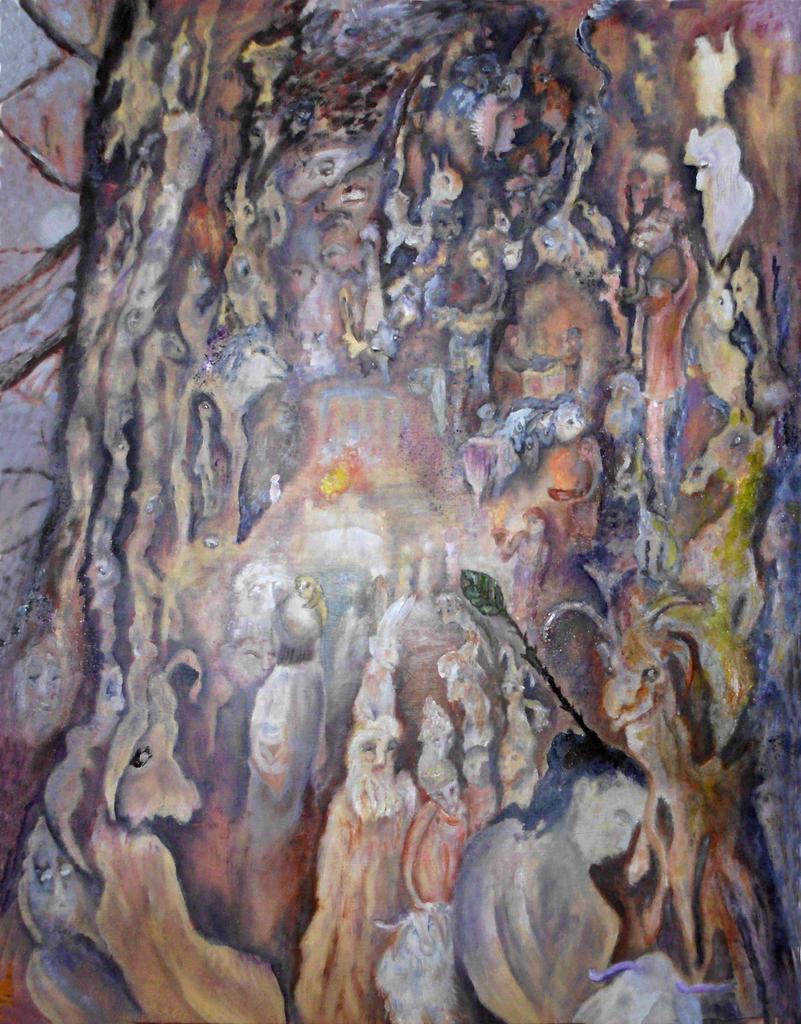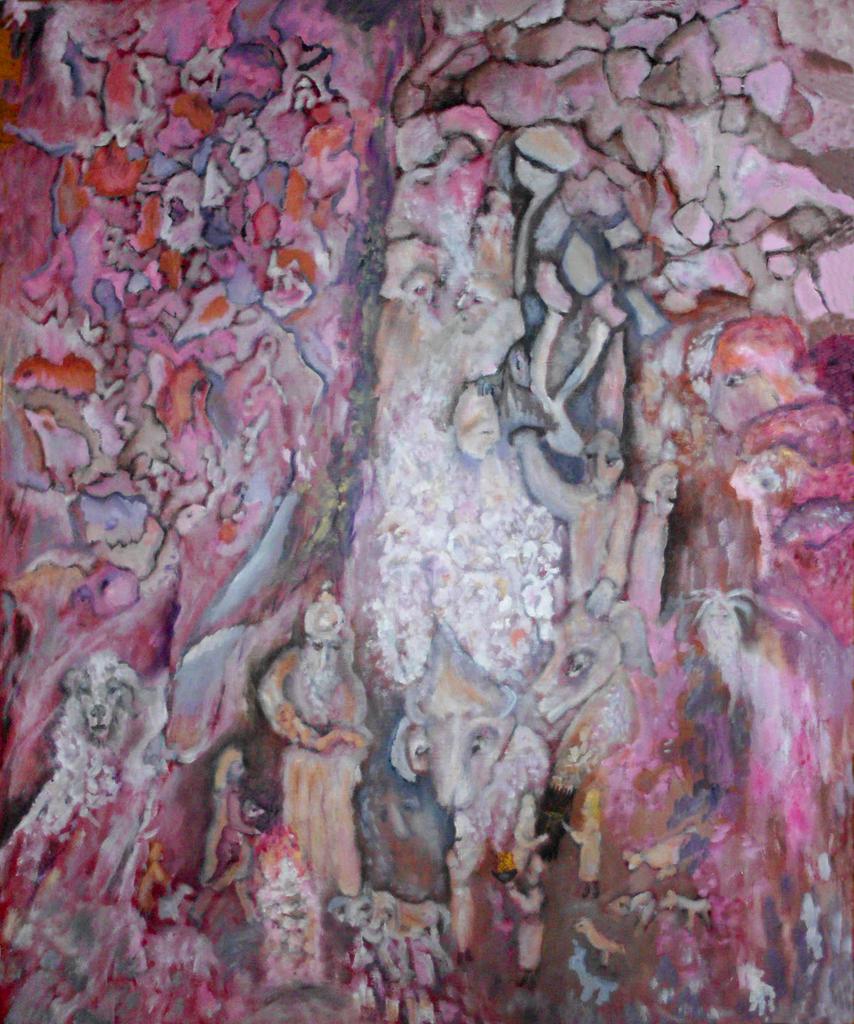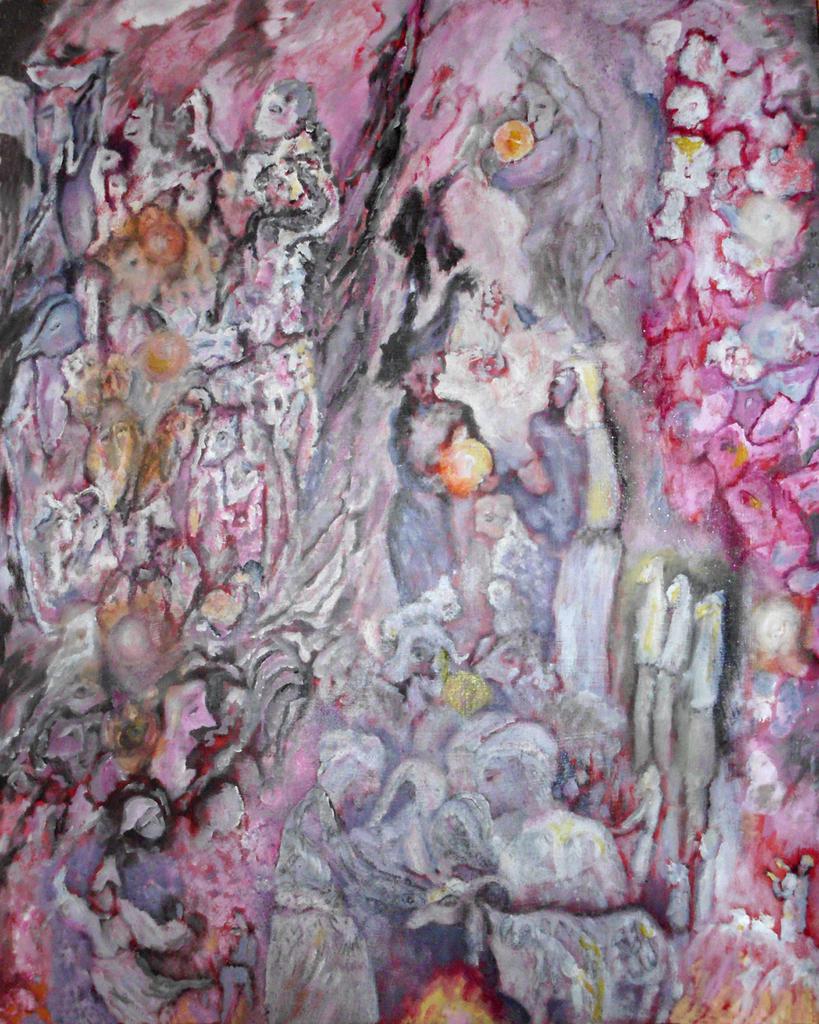


Video of the Rabbi and Artist in conversation about the Parsha:
https://www.theameninstitute.org/weekly-parasha-inspiration/tzav
For more about Artist Olesya "Olga" Volk: https://www.theameninstitute.org/olesya-volk
For more about Rabbi Leibish Hundert: https://www.theameninstitute.org/leibish-hundert
Discussion Questions:
1. Each image is filled with a significant number of faces and expressive eyes. How do you make sense of their role? What is the purpose of filling this image with so much activity?
2. Many of the figures seem to be floating, the shapes of their bodies melt into one another. What message is being conveyed through this. Is there an orientation or order in which one should observe these images? i.e. inside-out, top to bottom, left to right.
3. These images are painted on top of wood, and the titles themselves allude to trees. What do trees signify to you? What connection do trees have with Temple worship?
4. Each image contains orbs of light or miniature fire balls. Olesya describes these as the eternal light of the temple. Though an abstract concept, how do you relate to the concept of an eternal light? Is the light still eternal if the temple is no longer standing?
Piece Description, Olesya Volk, “The Temple Tree,” “The Tree of the Altar 1,” “The Tree of the Altar 2”:
My paintings come out as attempts to translate from the fantastic hieroglyphs that I see in the patterns of nature, mostly in the tree bark. In other words, they are sort of “snapshots” from the process of “reading” the Book of Nature by the mind. These snapshots exist some where in between the imagery and the language. I think that trees are folios and libraries that can be read, perhaps as well as any thing around if we attune to it. The mind projects meanings onto the shapes and lines, but they are being reflected back, startling and puzzling. there is always a sensation of a mirror dialog, of having been read by the Book of Nature itself.
In my study of Parshat Tzav, I discovered a revelation about the different invisible levels of connection between humans and the animal world. The levels where “to identify with one’s sacrificed animal” extend beyond metaphor and speak to the subtle levels of awareness that fill the existence. That brought out for me a sudden echo and a sublime confirmation of what I always attempt to achieve with my art – the sense of an encounter with the natural realm, both conscious and subconscious. The world where any small action or move is significant and makes a difference. In this regard, we are held accountable and asked to uphold a moral ethic. Finally, this work helped me contemplate the role of the inner fire in the human heart, which is seen as comparable to the eternal fire on the altar in the Temple.
Rabbi Leibush Hundert:
Let me invite you to the learning labretory that was our chevruta between myself and Olesya "Olga" Volk:
Olga was primarily concerned about the death of the innocent animals in all of the ritual sacrifices described in Vayikra in general and in Parashat Tzav (our Parashah) in particular.
Olga had studied some Lubavitch Hasidic teachings that she found online which spoke about lifting up the different dimensions of creation in the Temple, but she was still irked.
We spoke about a teaching of R. Yaacov Leiner, Rebbe of Izhbitz (1814-1878) who taught that when a person brings an animal sacrifice, they are actually meant to experience the innocence of the animal, and that it is through the very death of the animal that the person reaches new levels of life.
How can this be understood?
One way is through taking a look at the Thanksgiving Offering, which is an important feature of our parashah.
The goal can be understood as being to use the particular standout experience which was the impetus of the sacrifice, to reach a new level of thankfulness to Hashem throughout all of one’s life.
The innocent animal is a manifestation of a kind of flatline consciousness which is habit-based.
In its sacrificial death, this energy is broken through and elevated: it is like an outer layer of the person is dying, perhaps not unlike a kind of spiritual circumcision, only here the energy of that outer layer is not discarded, but rather becomes food.
Food for the Altar (in a certain way this is called food for Hashem!), for the priests, for the person who brought it, and for all of his or her friends and family who must be invited to join, for the Torah strictly commands that all the meat (of an entire cow, lamb or goat) plus forty loaves all must be eaten within just one night after the Thanksgiving offering is brought.
Through the act of the sacrifice, and the subsequent eating, the innocent but dumb consciousness can be elevated, to reach a new level of thankfulness that sees Hashem’s hand around every corner.
By identifying with it, (the law requires placing one’s hands on it and leaning with all one’s weight) but then sacrificing and elevating it, a new awareness can be born: death brings life.
In this sense, it is almost as if it is not really a “death” – meaning an absurd and terrifying “end” – but rather a meaningful and wondrous “beginning.”
We spoke about how, according to legend, the Baal Shem Tov had animals streaming out to him from the forest, wishing to be ritually slaughtered.
Then I saw the paintings.
Olga uses tree-bark as a kind of a muse to allow the twists and turns of the bark to spark images.
What stood out to me in particular where the many eyes of the animals, who, in great concentric but disorderly circles, watch from near and from far, as their kin are brought to the altar.
The solemnity and awe are palpable, as is the kind of ancient wisdom that is in the gnarly tree-bark.
This brought to mind the mitzvah of “fear of the Temple” – that one cannot wear shoes, nor bring one’s wallet, nor spit, nor make the place of the Temple into a shortcut: for something awesome happens “There.”
The leaf that is prominent and green holds a kind of reaching out for life-energy, striving to be near the fire of the Altar, as leaves strive to be in the Sunlight.
The pink/red coloring of her second painting brought out the hidden dimension of love that is inherent, too, to the process of sacrifice and the energy of the Temple. Here we see an image that looks perhaps like Avraham holding Yitzchak, near a great Ram: here too there is great love, hidden within the paradox of Hashem’s command to sacrifice Yitzchak, that is then transferred to a command to sacrifice the Ram.
And the final piece further fleshes out human dimension of sacrifices, where what might be Moshe and Aharon are central, with a flask of oil in Moshe’s hand, whereby, with great love, he gave the honor of becoming anointed as high-priest to his older brother.
Above them is what might be an angel, lovingly receiving the energy of the sacrifices, and around them, hidden, are other glowing orbs, that might represent the Sefirot, and how the whole chain of Creation is part of this glorious process.




